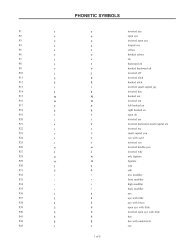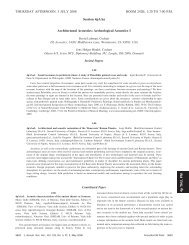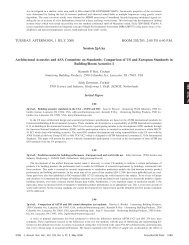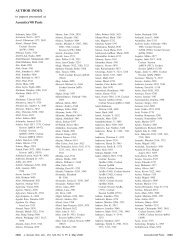Tuesday afternoon, 11 November - The Acoustical Society of America
Tuesday afternoon, 11 November - The Acoustical Society of America
Tuesday afternoon, 11 November - The Acoustical Society of America
Create successful ePaper yourself
Turn your PDF publications into a flip-book with our unique Google optimized e-Paper software.
4:15<br />
2pSP7. Acoustic Dopplergram for intruder defense. T. C. Yang Naval<br />
Res. Lab., 4555 Overlook Ave., Washington, DC 20375<br />
This paper discusses the concept and presents preliminary experimental<br />
results using the Dopplergram to detect and localize an underwater vehicle,<br />
intended for harbor defense and/or protection <strong>of</strong> high value assets. <strong>The</strong><br />
acoustic Dopplergram displays the Doppler frequency <strong>of</strong> the target echo<br />
from an active source as a function <strong>of</strong> time similar to the L<strong>of</strong>argram or<br />
Contributed Paper<br />
spectral gram, which is widely used in passive sonar for detection <strong>of</strong> tonal<br />
and/or wideband transient signals. m-sequence signals, which are sensitive<br />
to Doppler shift, are transmitted with a rapid repetition rate from a source<br />
and received on a colocated receiver. Target detection is improved using the<br />
processing gain <strong>of</strong> the m-sequence and using Doppler discrimination signal<br />
association by eye-ball integration <strong>of</strong> the Doppler gram data. <strong>The</strong> target is<br />
localized using a two-way travel time and bearing estimation. This work is<br />
supported by the US Office <strong>of</strong> Naval Research.<br />
TUESDAY AFTERNOON, <strong>11</strong> NOVEMBER 2008 LEGENDS 8, 1:30 TO 4:00 P.M.<br />
1:30<br />
2pUW1. A sparse-grid, nonintrusive formulation <strong>of</strong> acoustic field<br />
uncertainty in ocean waveguides. Steven Finette Naval Res. Lab., Washington,<br />
DC 20375-5320 and John Burkhardt U.S. Naval Acad., Annapolis,<br />
MD 21402<br />
<strong>The</strong> inclusion <strong>of</strong> environmental uncertainty in simulations <strong>of</strong> acoustic<br />
wave propagation in ocean waveguides is important for the development <strong>of</strong><br />
simulation-based prediction methods that quantify the influence <strong>of</strong> multiple<br />
sources <strong>of</strong> incomplete environmental knowledge on the simulation results.<br />
Polynomial chaos expansions have been suggested as a natural mathematical<br />
framework for describing both environmental and acoustic field uncertainties,<br />
their interaction, and propagation through the waveguide S. Finette, J.<br />
Acoust. Soc. Am. 120 2006. Previous research has described the inclusion<br />
<strong>of</strong> these expansions directly into the propagation equation the intrusive<br />
approach, yielding coupled differential equations for the expansion<br />
coefficients. <strong>The</strong> solution for the coefficients contains the statistical properties<br />
<strong>of</strong> the uncertain field. Here we describe an alternative nonintrusive formulation,<br />
where existing acoustic propagation codes can be used to estimate<br />
the chaos coefficients rather than solve for them via a complex set <strong>of</strong><br />
coupled differential equations. <strong>The</strong> nonintrusive formulation involves multiple<br />
solutions <strong>of</strong> an existing deterministic code, e.g., a wide-angle parabolic<br />
equation solver, in conjunction with the Smolyak sparse-grid interpolation<br />
and multidimensional quadrature to obtain uncertainty statistics on the<br />
acoustic field. Research supported by the Office <strong>of</strong> Naval Research.<br />
1:45<br />
2pUW2. A chaos-based wide-angle parabolic equation model for sound<br />
propagation in random ocean. Li Ma and Hao Xing Inst. <strong>of</strong> Acoust., Chinese<br />
Acad. <strong>of</strong> Sci., Beijing 100190, China, mary1968@tom.com<br />
Recently, the chaos-based methods have attracted much attention in<br />
ocean acoustics committee. In this paper, a set <strong>of</strong> partial differential equations<br />
PDEs, which are based on the wide-angle parabolic equation and<br />
Wiener-chaos decomposition, was established to investigate the propagation<br />
<strong>of</strong> sound propagation in the ocean environment with an arbitrary sound<br />
speed pr<strong>of</strong>ile. Simultaneously, a numerical treatment <strong>of</strong> the PDEs, which<br />
employed an implicit difference scheme and a spectral method, was<br />
developed. By using this method, three cases with different kinds <strong>of</strong> randomness<br />
under a distinct ocean environment are studied numerically.<br />
Session 2pUW<br />
Underwater Acoustics: Inversion and Uncertainty<br />
Steven Finette, Chair<br />
Naval Research Laboratory, Washington, DC 20375-5320<br />
Contributed Papers<br />
2:00<br />
2pUW3. Uncertainty and resolution in continuum inversion <strong>of</strong> ocean<br />
bottom geoacoustic properties. Andrew A. Ganse and Robert I. Odom<br />
Appl. Phys. Lab., Univ. <strong>of</strong> Washington, 1013 NE 40th St., Seattle, WA<br />
98105, aganse@apl.washington.edu<br />
Inversion <strong>of</strong> ocean bottom geoacoustic properties from acoustic receptions<br />
in the water column is a nonlinear inverse problem that is inherently<br />
unstable and nonunique. One common approach to stabilizing this problem<br />
is to assume that the ocean bottom is made up <strong>of</strong> a small number <strong>of</strong> layers.<br />
<strong>The</strong> solution from this approach does allow one to reproduce the scattered<br />
sound field if all the other experiment parameters such as frequency and geometry<br />
are also reproduced. However without extensive prior information<br />
about that ocean bottom, this approach yields only one <strong>of</strong> many equivalent<br />
nonunique solutions and may not accurately describe the actual ocean bottom<br />
itself. An alternate approach, which may allow one to reuse the results<br />
later with a different frequency or geometry, is to use the tools <strong>of</strong> geophysical<br />
continuum inversion to specify the degree <strong>of</strong> nonuniqueness by quantifying<br />
both the uncertainty and limited resolution <strong>of</strong> the continuum bottom<br />
solution. This work compares inversion uncertainty and resolution results<br />
for different formulations <strong>of</strong> the data e.g., matched field versus matched<br />
modes versus waveform, different geometries, and different formulations <strong>of</strong><br />
the uncertainty e.g., normally distributed versus including some higherorder<br />
moments. Work partially supported by ONR.<br />
2:15<br />
2pUW4. Resolution matrix perturbation series applied to a nonlinear<br />
ocean acoustic inverse problem. Robert I. Odom and Andrew A. Ganse<br />
Appl. Phys. Lab., Univ. <strong>of</strong> Washington, 1013 NE 40th St, Seattle, WA<br />
98105, odom@apl.washington.edu<br />
<strong>The</strong> resolution operator for a nonlinear inverse problem is the product <strong>of</strong><br />
the estimated inverse <strong>of</strong> the forward model operator and the forward model<br />
operator itself. If the inverse <strong>of</strong> the forward model operator were exact, then<br />
the resolution operator would be the identity, but in general the resolution<br />
operator describes the noninvertible transfer function between the unknown<br />
true environmental model and the limited-resolution version, which<br />
can be estimated from measurements. <strong>The</strong> nonlinear model resolution operator<br />
can be computed iteratively from the Neumann series representation<br />
<strong>of</strong> an estimate <strong>of</strong> the inverse <strong>of</strong> the forward model operator with the assumption<br />
that both the data functional and the model perturbation functional possess<br />
regular perturbation expansions. An example <strong>of</strong> a problem that fits these<br />
2501 J. Acoust. Soc. Am., Vol. 124, No. 4, Pt. 2, October 2008 156th Meeting: <strong>Acoustical</strong> <strong>Society</strong> <strong>of</strong> <strong>America</strong><br />
2501<br />
2p TUE. PM







